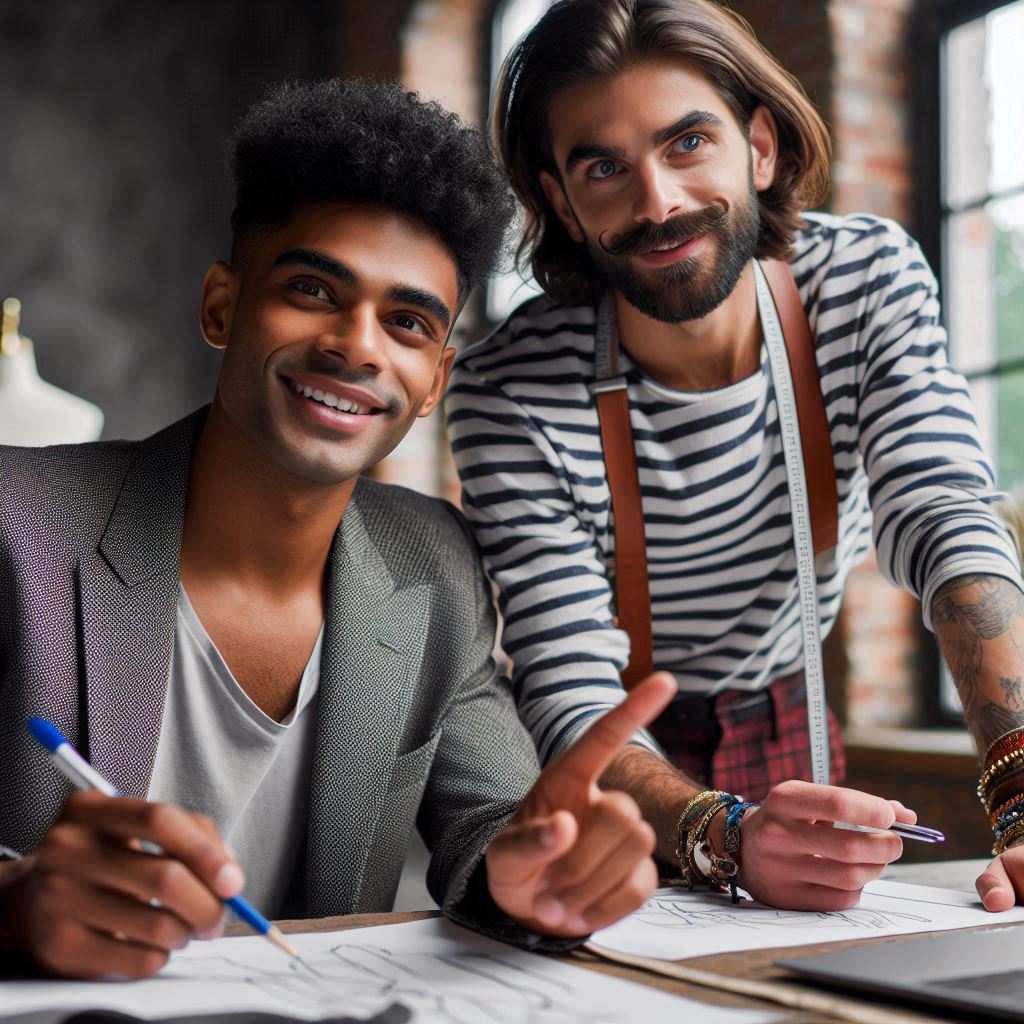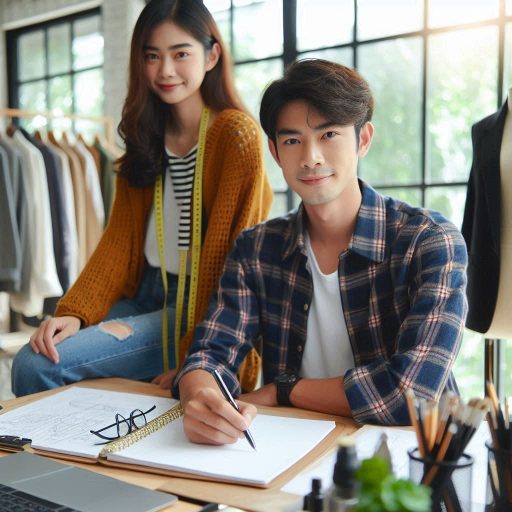Introduction
Fashion design thrives on creativity and collaboration.
It’s not a solitary pursuit but a collective effort.
In the fast-paced world of fashion, teamwork is essential.
Designers, stylists, and marketers must work in sync to bring a vision to life.
The industry demands coordination between various professionals to create cohesive collections.
Each member of the team plays a unique role in shaping the final product.
From initial sketches to the runway, teamwork drives the entire process.
Designers rely on pattern makers to translate ideas into wearable garments.
Fabric specialists ensure the material complements the design.
Stylists curate the overall look, while marketers strategize the collection’s launch.
Every team member contributes to a unified vision.
Effective communication is crucial in this collaborative environment.
Regular meetings and updates keep everyone aligned with the project goals.
Clear directives and feedback loops prevent misunderstandings and streamline the workflow.
In the world of fashion, where deadlines are tight and demands high, seamless communication can make or break a project.
Creativity flourishes in a collaborative setting.
Team members inspire one another, bringing diverse perspectives to the table.
Brainstorming sessions often lead to innovative solutions and unique designs.
The exchange of ideas among a well-knit team often results in groundbreaking fashion concepts.
Importance of teamwork in fashion design
Collaboration Leads to More Innovative and Creative Ideas
In fashion design, teamwork is crucial for success.
Collaborative efforts lead to more innovative and creative ideas.
When designers, pattern makers, and seamstresses work together, they blend their unique skills and visions.
This synergy often results in groundbreaking designs that set trends.
Each team member contributes a fresh perspective, pushing the boundaries of traditional design and fostering originality.
Helps to Streamline the Design Process and Meet Deadlines
Teamwork streamlines the design process and helps designers meet tight deadlines.
By dividing tasks among team members, the workload becomes manageable.
Designers focus on creativity while others handle technical aspects.
This division of labor prevents bottlenecks and keeps projects on track.
Clear communication and coordinated efforts ensure that all elements of the design come together seamlessly, making it easier to meet project milestones and final deadlines.
Encourages Diversity in Perspectives and Skills
Effective teamwork in fashion design fosters diversity in perspectives and skills.
Each team member brings different experiences and expertise to the table.
A diverse team can approach problems from various angles, enhancing problem-solving and leading to richer, more dynamic design solutions.
This variety of viewpoints often results in designs that are not only unique but also more inclusive, appealing to a broader audience.
Collaborating with a team also builds a supportive environment.
Designers can offer and receive feedback, leading to continuous improvement.
Constructive criticism helps refine ideas and elevate the quality of the final product.
This support network is invaluable, especially during challenging phases of a project.
In addition to creativity and efficiency, teamwork promotes learning and growth.
Team members can share knowledge and techniques, expanding their skills.
This environment of mutual learning helps individuals stay current with industry trends and innovations.
Strong communication is key to successful teamwork.
Regular meetings and clear dialogue ensure everyone stays aligned with the design vision.
Open communication helps prevent misunderstandings and keeps the project on the right path.
Ultimately, working with a team in fashion design creates a dynamic and productive environment.
Collaboration leads to high-quality designs that push boundaries.
By valuing each member’s contributions, designers can achieve their creative goals and meet project deadlines effectively.
Embracing the collaborative nature of the fashion industry is essential for achieving the best results and maintaining a competitive edge.
Read: Top Skills Needed for Art Educators and Instructors
Roles Within a Fashion Design Team
1. Designers: Responsible for Creating the Overall Vision and Concept
Designers are the visionaries in the fashion design team.
They sketch ideas, select fabrics, and establish the collection‘s concept.
Their role involves shaping the aesthetic direction and ensuring that each piece aligns with the overall theme.
Designers provide the blueprint that guides the entire team‘s efforts.
2. Pattern Makers: Bring the Designs to Life Through Technical Skills
Pattern makers translate the designer’s sketches into wearable patterns.
They use technical skills to create templates for garment construction.
Their role is crucial in turning creative ideas into practical, executable designs.
Precision is key as they ensure that the final garments reflect the designer‘s vision accurately.
3. Seamstresses: Execute the Construction of Garments
Seamstresses are responsible for the actual construction of garments.
They sew pieces together based on the patterns created by pattern makers.
Attention to detail is essential to ensure that garments fit well and maintain the designer‘s intended look.
Seamstresses transform fabric and thread into stylish, finished pieces.
4. Stylists: Coordinate the Final Look and Presentation
Stylists play a key role in coordinating the final look and presentation of the collection.
They select accessories, choose hairstyles, and determine the overall presentation of the garments.
Their work ensures that the collection is showcased effectively, enhancing the designer‘s vision and ensuring a cohesive presentation.
In a fashion design team, each role is interdependent.
Designers rely on pattern makers to bring their concepts to life.
Pattern makers depend on seamstresses for accurate garment construction.
Seamstresses look to stylists for guidance on how the finished pieces should be presented.
Effective communication and collaboration are vital for success.
Designers must clearly articulate their vision to pattern makers.
Pattern makers need to work closely with seamstresses to address any technical issues.
Seamstresses and stylists must coordinate to ensure that the final presentation meets expectations.
A successful fashion design team thrives on teamwork.
Each member‘s expertise contributes to the overall success of the collection.
Designers‘ creativity is supported by pattern makers‘ technical skills.
Seamstresses‘ craftsmanship is enhanced by stylists‘ eye for presentation.
Understanding each role‘s importance helps create a harmonious working environment.
It ensures a seamless workflow from concept to final showcase.
The synergy between team members is key to transforming creative ideas into stunning fashion collections.
Read: Collaborating with Other Creative Roles
Effective communication within a fashion design team
Clear and Open Communication is Essential for Successful Collaboration
Clear and open communication stands as the cornerstone of a successful fashion design team.
It ensures everyone is aligned with the project’s vision and goals.
Without it, misunderstandings can arise, leading to delays and conflicts.
Encouraging an environment where team members feel comfortable sharing their ideas is vital.
This approach fosters creativity and innovation, which are crucial in fashion design.
Regular Team Meetings to Discuss Progress, Challenges, and Feedback
Regular team meetings play a critical role in maintaining effective communication.
Schedule meetings to discuss progress, address challenges, and provide constructive feedback.
These meetings keep the team informed and engaged.
They also help in identifying potential issues early on, allowing for timely solutions.
Regular discussions prevent small problems from escalating into major setbacks.
Additionally, they keep everyone on the same page regarding deadlines and responsibilities.
Utilization of Digital Tools for Sharing Ideas and Files
Utilizing digital tools enhances communication within the team.
Platforms like Slack, Trello, or Asana streamline the sharing of ideas and files.
These tools enable team members to collaborate efficiently, regardless of their physical location.
Digital communication also allows for real-time updates and instant feedback, which accelerates decision-making processes.
This immediacy helps keep the project on track and minimizes misunderstandings.
Sharing ideas digitally also provides a record of discussions and decisions.
This documentation is invaluable for referencing past conversations and ensuring consistency.
It also aids in tracking the project’s evolution, from initial concepts to final designs.
By leveraging these tools, teams can maintain a clear and organized workflow.
Moreover, digital tools offer the benefit of integrating various aspects of fashion design projects.
For example, a design team can use shared folders to keep all sketches, fabric samples, and color palettes accessible to everyone.
This centralized access ensures that all team members have the latest updates and resources.
It also helps prevent the loss of important information and keeps the creative process fluid.
Effective communication within a fashion design team is not a one-time effort.
It requires ongoing attention and adaptation to the team’s needs.
Encouraging open dialogue, holding regular meetings, and utilizing digital tools are essential practices for fostering a collaborative environment.
By focusing on these areas, a fashion design team can enhance its efficiency, creativity, and overall success in bringing innovative designs to life.
Read: Historic Costume Design Inspirations
Building a strong team dynamic
Foster a Positive and Inclusive Work Environment
Creating a thriving fashion design team starts with fostering a positive and inclusive work environment.
A supportive atmosphere is essential for boosting creativity and enhancing productivity.
Encourage open communication among team members to build trust and strengthen relationships.
When team members feel respected and valued, they are more likely to contribute their best ideas and efforts.
Celebrate individual achievements and collective successes to uplift team morale.
Inclusivity is a key driver of innovation; blending diverse perspectives often leads to groundbreaking designs and fresh concepts.
Make sure every team member feels heard and valued, and actively promote a culture of respect and collaboration.
Encourage Brainstorming Sessions and Idea Sharing
Regular brainstorming sessions are crucial for generating innovative ideas and keeping designs fresh.
Schedule these sessions frequently to allow everyone to contribute their thoughts and suggestions.
Create an environment where team members feel comfortable sharing their ideas without fear of judgment.
Encourage free thinking and unconventional solutions, as these can lead to unique and creative outcomes.
Use brainstorming sessions to explore new trends and address design challenges collaboratively.
Diverse inputs can spark unexpected solutions and push the boundaries of your design projects.
By fostering an open and collaborative atmosphere, you help ensure that your team remains engaged and creative.
Establish Roles and Responsibilities to Avoid Conflicts
Clearly defined roles and responsibilities are vital for maintaining a smooth workflow and preventing conflicts within the team.
Each team member should have a clear understanding of their specific duties and how these contribute to the overall project.
Overlapping responsibilities can lead to confusion and disputes, so it‘s important to delineate tasks carefully.
Assign roles based on each person‘s strengths, expertise, and interests to ensure that everyone is working efficiently.
Regularly review and adjust roles as necessary to reflect changes in the project or team dynamics.
By providing clarity and structure, you minimize the risk of misunderstandings and ensure that the team operates harmoniously.
Building a strong team dynamic involves consistent effort and attention to various aspects of team management.
By fostering a positive and inclusive environment, encouraging regular idea sharing, and establishing clear roles and responsibilities.
You create a foundation for a productive and creative fashion design team.
These practices not only enhance individual performance but also contribute to the overall success and innovation of the team‘s projects.
Read: Breaking Down Iconic Movie Costumes

Handling disagreements and conflicts within a team
Address Issues Promptly and Constructively
In the fashion design world, conflicts within a team can arise.
Addressing these issues promptly and constructively is crucial.
Ignoring disagreements can escalate tensions and disrupt team dynamics.
Tackle conflicts head-on by recognizing the issue and its impact on the team.
Act quickly to prevent minor problems from growing into major obstacles.
Addressing issues directly helps maintain a positive and productive work environment.
Encourage Open Dialogue and Respect for Different Opinions
Creating an open dialogue is essential for resolving conflicts.
Encourage team members to voice their opinions and share their perspectives.
Respect for different viewpoints fosters collaboration and understanding.
Establish a space where everyone feels comfortable expressing their thoughts without fear of criticism.
Listening actively and empathetically helps bridge gaps in understanding and strengthens team cohesion.
This approach ensures that conflicts are addressed in a respectful and inclusive manner.
Transform Your Career Today
Unlock a personalized career strategy that drives real results. Get tailored advice and a roadmap designed just for you.
Start NowSeek Compromises and Solutions That Benefit the Entire Team
When conflicts arise, seek compromises that benefit the entire team.
Focus on finding solutions that meet the collective needs and goals.
Explore various options and assess their potential impacts on the team.
Aim for resolutions that satisfy everyone involved rather than seeking to “win” the argument.
Collaborative problem-solving turns disagreements into opportunities for growth and enhances overall team productivity.
By working together to find mutually beneficial solutions, the team can overcome conflicts and continue to move forward effectively.
In summary, managing disagreements within a fashion design team requires prompt and constructive action, open dialogue, and collaborative problem-solving.
Addressing issues early helps prevent escalation.
Encouraging respectful communication and seeking solutions that benefit the entire team fosters a positive and productive work environment.
This approach not only resolves conflicts but also enhances team unity and overall effectiveness.
Benefits of Diversity in a Fashion Design Team
Different Perspectives and Backgrounds Lead to More Innovative Designs
Diversity in a fashion design team fuels creativity and innovation.
When team members come from varied backgrounds, they bring unique perspectives.
These differing viewpoints can inspire fresh design ideas and concepts.
A diverse team is more likely to explore unconventional styles and trends.
They approach problems from multiple angles, leading to more innovative solutions.
Encourages Inclusivity and Representation in the Industry
Inclusive teams naturally reflect the society they aim to serve.
A mix of cultural, ethnic, and gender backgrounds helps ensure designs resonate with a broader audience.
This inclusivity in design promotes greater representation in the industry.
It allows for the creation of collections that cater to diverse consumer needs and preferences.
Strengthens Team Dynamics by Bringing Together Unique Skill Sets
Incorporating a variety of skill sets into a fashion design team enhances its overall strength.
Each team member contributes specialized expertise, whether in textiles, pattern making, or digital design.
This broad range of skills can streamline the design process and improve the final product.
Collaboration among individuals with different strengths fosters a more dynamic and effective team environment.
Moreover, working in a diverse team can enhance problem-solving abilities.
Members with different experiences approach challenges in unique ways.
This collective problem-solving approach can lead to more creative and effective solutions.
Diversity also promotes a culture of continuous learning and growth within the team.
A diverse team can also improve the fashion brand’s market reach.
By understanding and addressing the needs of a varied clientele, the team can create designs that appeal to a global market.
This strategic advantage can set a brand apart in a competitive industry.
It opens opportunities for broader market engagement and increased brand loyalty.
Additionally, teams with diverse backgrounds are better equipped to address emerging fashion trends.
They can anticipate and react to shifts in consumer preferences more effectively.
This proactive approach helps brands stay relevant and ahead of the curve.
It ensures that their designs remain fresh and appealing in a rapidly evolving market.
In a nutshell, diversity in a fashion design team brings numerous benefits.
It drives innovation by incorporating varied perspectives, promotes inclusivity and representation, and strengthens team dynamics.
Embracing diversity not only enhances creativity but also contributes to a more dynamic and successful fashion industry.
Gain More Insights: Top Online Communities for Web Designers
Case Studies of Successful Fashion Design Teams
Fashion design is often perceived as an individualistic endeavor, but behind every iconic collection is a dynamic team.
Collaborative efforts have fueled the success of numerous fashion houses and designers.
Let’s explore some standout examples of teamwork that transformed the fashion industry.
Examples of renowned fashion houses and designers known for their collaborative work
1. Chanel: A Legacy of Collaboration
Chanel‘s success story is deeply intertwined with teamwork.
Gabrielle ‘Coco‘ Chanel founded her house, but her vision was realized with the support of key collaborators.
Her close work with designer Karl Lagerfeld, who joined the house in 1983, breathed new life into Chanel.
Lagerfeld‘s innovative ideas complemented Chanel‘s classic elegance, creating a timeless synergy.
Their combined efforts established Chanel as a symbol of modern luxury and sophistication.
2. Louis Vuitton: A Fusion of Creativity and Precision
Louis Vuitton‘s ascent to global prominence also highlights the power of teamwork.
The brand, originally known for its luxury luggage, expanded its horizons through collaborations.
Working with artists like Takashi Murakami and Yayoi Kusama, Vuitton infused its classic designs with vibrant, contemporary elements.
These collaborations were not merely about adding artistic flair.
They involved close coordination between the fashion house‘s designers and the artists, blending different creative visions into cohesive collections.
3. Prada: Innovative Team Dynamics
Prada stands out for its innovative approach to teamwork.
Miuccia Prada, the creative force behind the brand, is known for her collaboration with her husband, Patrizio Bertelli.
Together, they transformed Prada into a powerhouse of contemporary fashion.
Bertelli‘s business acumen and Prada‘s design genius created a perfect balance.
Their teamwork ensured Prada‘s unique style remained at the forefront of fashion, integrating avant-garde concepts with market trends.
4. Raf Simons and Peter Saville: A Creative Alliance
Raf Simons and Peter Saville’s collaboration offers another compelling case study.
Simons, a renowned designer, teamed up with Saville, a prominent graphic designer, to produce groundbreaking work.
Their partnership merged fashion and art, resulting in collections that challenged traditional fashion norms.
Their collective efforts brought a fresh perspective to the industry, showcasing how diverse talents can create extraordinary outcomes when united.
How teamwork contributed to their success and recognition in the industry
1. Balenciaga: Pioneering Teamwork
Balenciaga‘s success under Crist‘bal Balenciaga‘s leadership exemplifies effective teamwork.
Balenciaga was known for his meticulous approach to design, but his achievements were supported by his skilled team.
His atelier was a hub of creative minds, each contributing to the brand‘s innovative designs.
The synergy within his team played a crucial role in establishing Balenciaga as a trailblazer in fashion.
2. Teamwork in Fashion: A Common Thread
These case studies illustrate that success in fashion design often hinges on teamwork.
Collaborative efforts allow designers to blend different skills and perspectives, resulting in groundbreaking collections.
Whether through close partnerships or creative alliances, these fashion houses demonstrate that teamwork is an essential ingredient in achieving industry acclaim.
The collective talent and vision of a team can turn a single idea into a global fashion phenomenon.
Conclusion
Fashion design thrives on teamwork.
The collaborative process fuels innovation and brings creative visions to life.
Successful fashion collections are rarely the result of solo efforts; they are built on the synergy of a dedicated team.
From sketching initial concepts to final runway presentations, every step involves multiple minds working in harmony.
Effective teamwork in fashion design hinges on clear communication.
Designers, pattern makers, and seamstresses must share ideas openly.
Misunderstandings can derail projects, so articulate discussions and feedback are crucial.
Team meetings should be structured yet flexible, allowing space for creativity while maintaining focus on objectives.
Another key strategy is leveraging each team member’s strengths.
Every individual brings unique skills to the table.
Recognizing and utilizing these strengths enhances the overall output.
A designer might excel in visual concepts, while a technical designer might be adept at garment construction.
Combining these skills results in a well-rounded and polished final product.
Respect and trust are fundamental in a fashion team.
Team members should value each other’s contributions and build mutual respect.
When trust is established, members feel more confident sharing bold ideas.
This openness fosters a creative environment where innovation flourishes.
Encouraging each other and celebrating successes further strengthens team cohesion.
[E-Books for Sale]
The Big Book of 500 High-Paying Jobs in America: Unlock Your Earning Potential
$19.99 • 500 High-Paying Jobs • 330 pages
Explore 500 high-paying jobs in America and learn how to boost your career, earn more, and achieve success!
See All 500 High-Paying Jobs of this E-Book
1001 Professions Without a Degree: High-Paying American Jobs You Can Start Now
$19.99 • 1001 Professions Without a Degree • 174 pages
Discover 1001 high-paying jobs without a degree! Unlock career tips, skills, and success strategies for just $19.99!




